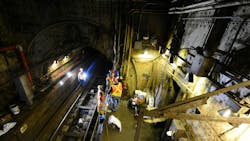MTA cancels planned L Train shutdown; work will proceed using alternative schedule
The Metropolitan Transportation Authority (MTA) has cancelled a planned 15-month shutdown of the Canarsie Tunnel following recommendations made by an expert panel that the L Train tunnel could be repaired while service continues.
The panel was brought together by New York Gov. Andrew Cuomo and consisted of engineering experts from Columbia and Cornell Universities who were charged with examining the current plan and recommending new designs, new systems or technology that would improve the project and/or expedite the timetable, or confirm the current plan as the best way forward.
The panel determined a complete closure of the L Train tunnel is unnecessary and the report of the panel's findings, presents a series of innovative engineering methods to streamline the required repair work and limit the impact on L Train service, which provides 400,000 daily rides. Work could be completed on nights and weekends only, with a single tube providing continued service in both directions during work periods. The work to repair and fortify the tunnel is achievable within a 15- to 20-month timeframe.
The MTA still plans to implement additional subway service where needed, including on the G, M and 7 Trains.
“We appreciate the dedication and the analysis provided by this group of experts,” said Acting MTA Chair Fernando Ferrer. “We have a shared goal in this effort: to make sure New Yorkers are subjected to the least possible disruptions as a result of this necessary repair work. With the L Project, and all our major projects, we’re consistently looking for new and innovative methods, and the guidance and recommendations we have received today will ease the strain on customers and help us ensure we are providing a consistently reliable service.”
The panel recommended a system design approach to the project, which achieves all functional outcomes, while reducing work and allowing simultaneous, not sequential execution of critical tasks. This system design approach could also be applied to other major MTA projects such as Second Avenue Subway Phase 2 and Hudson River Train Tunnels.
The L Train Project rebuilding and improvements will continue as planned to address long–term capacity on the line. These include constructing new power substations; storm and flooding resiliency measures; and station improvements, such as providing ADA accessibility and other capacity upgrades at the Bedford Avenue Station in Brooklyn and the 1st and 6th Avenue Stations in Manhattan.
The 100-year-old, 1.5-mile-long Canarsie Tunnel runs under the East River and sustained major damage after it filled with corrosive salt water due to Superstorm Sandy in 2012. Of the nine tunnels that were damaged during the storm, MTA said the Canarsie Tunnel was hardest hit with severe damage to the Circuit Breaker House, system and power cables, and the cement benchwall that holds and protects the cables.
Part of the previously planned 15-month shutdown of the tunnel was the removal, by hand, of the benchwall, installing 126,000 feet of power cable and 176,000 feet of communications cable inside the benchwall and then replacing the benchwall.
The expert review team found that modern rail tunnel designs under construction across the world do not sue benchwalls to protect cables. The team recommended implementation of a racking system design to suspend cables on side of tunnel and jacket cables with low smoke, zero halogen fireproof material.
“The L Train Tunnel project gives us the opportunity to integrate technologies and methods that have never been used before in a tunnel rehabilitation project, putting New York in a leadership position when it comes to building 21st century infrastructure,” the panel of engineering experts said in a joint statement. “We have proposed a forward-thinking, innovative approach that relies on state-of-the-art technologies to rehabilitate this century-old tunnel. We were grateful to have this extraordinary opportunity to work with the MTA to lead the way in infrastructure design and development, and we hope this solution can set an example for other projects in New York and around the world.”
In 2017, MTA awarded a $477-million contract for the tunnel work to a joint venture consisting of Judlau Contracting Inc. and TC Electric. At the time, the contract called for an accelerated schedule that included the 15-month shutdown, which was three month less than a previously expected shutdown of 18 months for the work to occur. In MTA's communication on the expert review team, there was no mention of how the recommendations adopted by MTA will affect the previously awarded contract.

Mischa Wanek-Libman | Group Editorial Director
Mischa Wanek-Libman is director of communications with Transdev North America. She has more than 20 years of experience working in the transportation industry covering construction projects, engineering challenges, transit and rail operations and best practices.
Wanek-Libman has held top editorial positions at freight rail and public transportation business-to-business publications including as editor-in-chief and editorial director of Mass Transit from 2018-2024. She has been recognized for editorial excellence through her individual work, as well as for collaborative content.
She is an active member of the American Public Transportation Association's Marketing and Communications Committee and served 14 years as a Board Observer on the National Railroad Construction and Maintenance Association (NRC) Board of Directors.
She is a graduate of Drake University in Des Moines, Iowa, where she earned a Bachelor of Arts degree in Journalism and Mass Communication.


